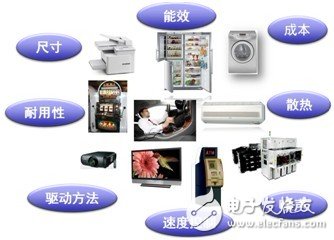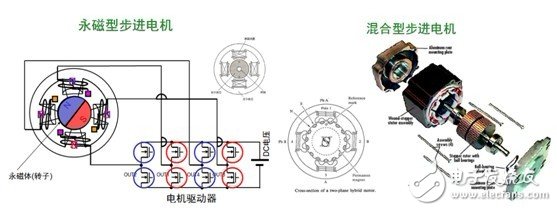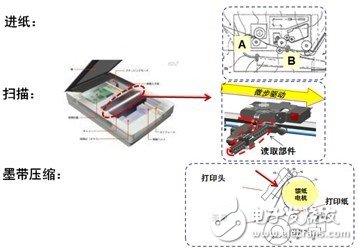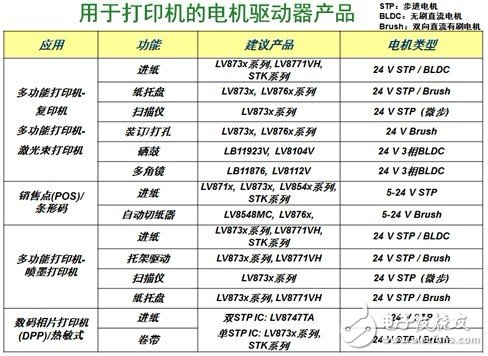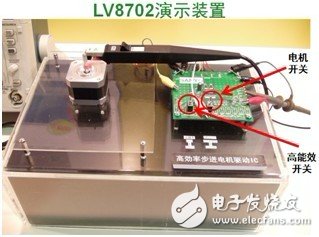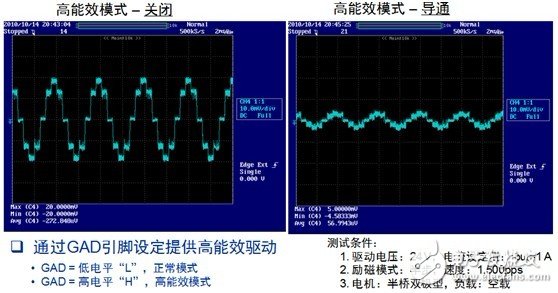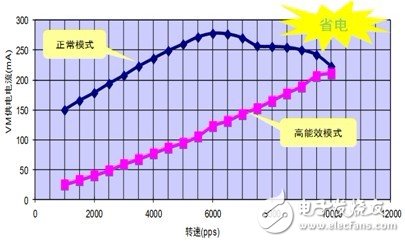The application of the motor is very wide, covering all areas of people's work and life, such as printers, copiers, fax machines, projectors, refrigerators, washing machines, air conditioners, gas stoves, cameras, ATM machines, electric sewing machines, security cameras, vending machines , Hot water supply system, garden irrigation system and industrial automation. Nowadays, energy saving is more and more important, the drive motor with high energy efficiency is particularly important. In terms of types, motors include AC motors, DC brush motors, DC brushless motors, permanent magnet synchronous motors, servo motors, and stepper motors. Among them, the stepper motor uses pulse operation, also known as digital motor or pulse motor. The rotation angle of the stepper motor is proportional to the number of pulses, and the speed is proportional to the pulse frequency. The rotation of the stepper motor can be precisely controlled by controlling the number of pulses, making it very suitable for positioning applications. This article will explore the common challenges of stepper motor drives and highlight ON Semiconductor ’s high-efficiency stepper motor driver solutions for office automation equipment applications. Common challenges for stepper motor drive applications Motor drives can be used in many different applications. Design engineers face some common challenges when using motor drives in their designs. First, most designs today require motor drive applications and related motor drive ICs and components to provide low energy consumption and high energy efficiency. For example, if the fan driver circuit board is inside the sealed housing, heat will be generated, requiring additional energy consumption to cool it. Therefore, it is necessary to use the built-in fan to circulate cold air inside to reduce heat and manage heat dissipation. Therefore, engineers may require low power consumption, but also require powerful, energy-efficient cooling motors. Figure 1. Examples of motor driver applications and their common challenges. Secondly, from the perspective of the end user, it is extremely necessary to reduce the noise generated by the motor to avoid discomfort. The designer must also be able to compensate for any external noise or vibration in the system. Thirdly, whether it is because of limited living space or user preference, it is an ordinary consumption trend that consumers have high demand for compact solutions. This trend has made smaller size and low noise motors more preferred, but this is not always possible when trying to compensate for other design requirements. It is worth noting that the durability and safety of motors and motor drivers are critical because high-voltage power supplies are required to drive white goods and industrial applications. Not to mention that engineers need to choose reliable motors that can accurately control the speed. Working principle of permanent magnet and hybrid stepper motors Stepper motors are often used in precision control applications, and use techniques like microstepping to reduce motor vibration. Figure 2 shows a schematic diagram of the working principle of permanent magnet stepper motors and hybrid stepper motors. Stepper motors work in the form of digital pulses, often called synchronous motors or pulse motors. The stepper motor controls the rotation by turning on and off the MOSFET. Figure 2. Working principle of permanent magnet and hybrid stepper motors. Taking the left side of Figure 2 as an example, when current flows through the MOSFET switches OUT1 and OUT2, the position of the permanent magnet rotor is shown in the left figure. The rotor position can be controlled by controlling the current of OUT1, 2, 3 and 4. The rotation angle is proportional to the number of pulses, and the rotation speed is proportional to the frequency of the pulse. You can precisely control the rotor position by controlling the number of pulses to make it suitable for positioning. Stepper motor and driver products for office automation equipment applications As mentioned earlier, the application of stepper motors is very wide. For example, it is used for cash input control and passbook roll-in functions in ATMs, as well as for goods movement in vending machines, and for wheels in slot machines Disk rotation, etc. The focus of this article is on stepper motors and drivers for office automation applications. Typical products are printers and scanners. Normally, functions such as paper feed, paper tray and scanning may use stepper motors for position control. Figure 3: Application examples of stepper motors and drives in common office automation equipment. As shown in Figure 3, the stepper motor accurately moves the paper from point A to point B. If the first requirement of the end user is silent drive, then it is suitable to use low-vibration micro-stepping motor. In such applications, stepper motors and DC brushless motors are used to press the ink ribbon onto the paper. A stepper motor is required to adjust the pressure of the ink ribbon on the paper where it needs to be positioned. In desktop scanners and other equipment, designers choose motors with positioning function, low vibration and motor rotation control range ON Semiconductor, which promotes energy-efficient innovation, offers a broad lineup of motor driver products for various typical motor applications. Table 1 lists only ON Semiconductor's motor driver products for printers and other applications (in addition to stepper motors, it also includes brushless DC motors and DC brushed motors) for designers' modeling reference. Table 1: Overview of ON Semiconductor's motor driver products for common office automation equipment such as printers. LV8702 high efficiency stepper motor driver features, advantages and application examples At present, the low energy efficiency of stepper motors used in a variety of electronic products has become a focus of the industry's attention and has also brought challenges to power supply system design engineers. ON Semiconductor's LV8702 high-efficiency stepper motor driver IC overcomes these challenges, provides a unique drive system, helps save the no-load energy consumption of the motor, and provides multiple application advantages. The LV8702's supply voltage VM ranges from 9 to 32 V and supports a maximum of 36 V; the output current is 2.5 A and supports a peak current of 3 A. The output on-resistance of this device is only 0.55 Ω, which helps drive the stepper motor with high energy efficiency. LV8702 has built-in high energy efficiency mode, out-of-step detection function and output short-circuit protection function, which helps reduce motor drive energy consumption, reduce heat generation, reduce vibration and noise, and provide high reliability. Typical applications of the LV8702 include office automation equipment such as photocopiers, document scanners, multi-function printers, and industrial equipment such as sewing machines and entertainment equipment such as slot machines. Figure 4. ON Semiconductor LV8702 high energy efficiency stepper motor driver IC application demonstration device. In order to highlight the application advantages of the LV8702 stepper motor driver, ON Semiconductor built a demonstration device as shown in Figure 4. We first turn on the motor switch. This switch enables the LV8702 motor driver IC to show its effectiveness. As the motor starts to run, let's measure the motor current waveform. Then, while maintaining the motor drive, we turn on the energy-efficient switch. The current waveform test results are shown in Figure 5. The left side shows the drive current of the motor driver when the high-efficiency switch is not enabled, and the right side shows the situation after turning on the high-efficiency switch. It can be seen that the drive current is significantly reduced, indicating lower energy consumption. Figure 5. The LV8702 can provide a high-efficiency drive mode through the GAD pin design, helping to reduce the average current and reduce energy consumption. The LV8702 high energy efficiency mode reduces the average current, which in turn reduces the heat generated. The IC surface temperature test shows that when the high-efficiency switch is enabled, the surface temperature of the driver IC and the motor drops by 46 ° C and 28 ° C, respectively. This feature has the potential to eliminate cooling fans in some applications, save space and cost, and enhance system reliability. In addition, by comparing the motor VM current, it was found that the LV8702 can save energy consumption by up to 80% (see Figure 6). Designers can use LV8702 to develop high-efficiency office automation equipment, and meet the needs of the world for improving energy efficiency. Figure 6. By comparing the motor VM current, it can be found that the LV8702 can significantly save the motor's energy consumption. The LV8702 has a built-in charge pump circuit for driving high-side N-channel MOSFETs. LV8702 supports 4 microstep modes, including full step, half step (full torque), half step and 1/4 step, etc., which can help reduce motor vibration and reduce noise. This device has a built-in output short-circuit protection function to provide protection against output short circuit to power supply, output short circuit to ground and load short circuit. to sum up: For today's power supply system designers, to comply with energy efficiency regulations around the world and the higher demand for energy saving by end users, not only to improve the power supply's energy efficiency, improve power factor and reduce light load and standby energy consumption, but also to enhance today's The energy efficiency of motors widely used in electronic products reduces their energy consumption and provides reliability. In response to these needs, ON Semiconductor provides a broad lineup of energy-efficient motor driver products. This article focuses on the common challenges of stepper motor drives and their working principles. It provides an overview of ON Semiconductor ’s product series for stepper motor drives. It highlights the characteristics of ON Semiconductor ’s LV8702 high-efficiency stepper motor drivers, combined with the demonstration device The test result introduces its application advantages and aims to help designers use this series of ICs to develop energy-efficient office automation equipment motor drive applications, occupying a favorable position in the market competition. Easy Electronic Technology Co.,Ltd , https://www.yxpcelectronicgroups.com